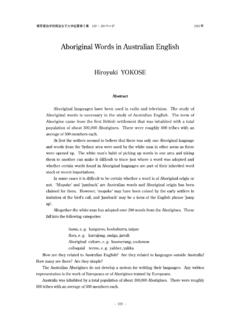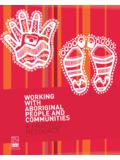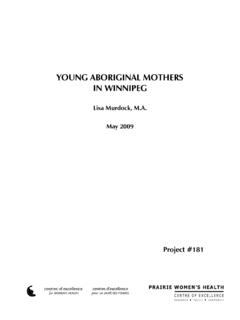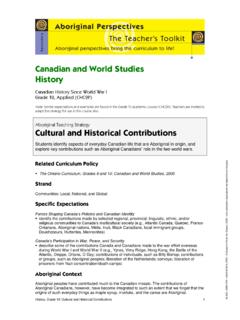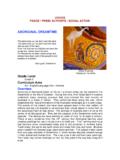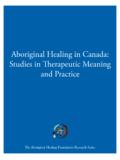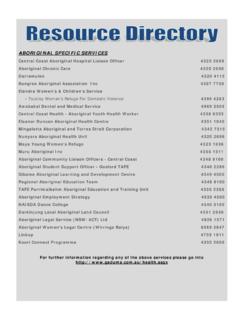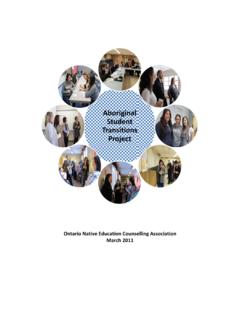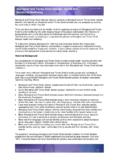Transcription of THE WELLNESS WHEEL: AN ABORIGINAL …
1 THE WELLNESS wheel : AN ABORIGINAL CONTRIBUTION TO SOCIAL WORK By Loiselle, Margot, PhD, & McKenzie Lauretta Msw Universit du Qu bec en Abitibi-T miscamingue 675, 1st Avenue, Val-d Or, Qu bec, J9P 1Y3 From a workshop conducted on May 27, 2006 at the First North-American Conference on Spirituality and Social Work, held at the University of Waterloo, Renison College, in Waterloo, Ontario, May 25-27, 2006 Entitled Breaking Barriers and Creating Common Ground Through a Holistic Approach: The Medicine wheel ABSTRACT: This contribution to the helping professions focuses on social intervention with the individual. It stems from an ABORIGINAL philosophy of life which promotes health and WELLNESS through a fully ecological and holistic approach based on the Medicine wheel . Thus, this paper presents a North-American ABORIGINAL worldview as a comprehensive and spiritual approach to life.
2 It explains the nature of this approach to health and healing and demonstrates the relevance of such an approach for various cultures in today s world. It offers a practical set of exercises in four steps leading to the development of a person s self-care plan called My WELLNESS wheel and makes some recommendations as to its use. The article concludes by reiterating briefly the major components of this ancient worldview and approach to helping and its relevance for today s society. 2 TABLE OF CONTENTS Page 1. Introduction 3 2. The Native Worldview and Philosophy of Life 4 3.
3 The Nature and Relevance of a Holistic, Fully Ecological Approach to Wellbeing 7 4. The Medicine wheel : Characteristics and Objectives 11 5. The WELLNESS wheel : A Program in Four Steps: 12 Step 1: My Life Today : A Snapshot 13 Step 2: My Life Today : A Graph 14 Step 3: Reflection on My Life 15 Step 4: My WELLNESS wheel - A Self-Care Plan 17 6. Recommendations 18 7. Conclusion 19 8. References 20 3 THE WELLNESS wheel : AN ABORIGINAL CONTRIBUTION TO SOCIAL WORK 1.
4 Introduction According to Calvin Morrisseau, an Ojibway healer (1998:90), the fundamental principle of life is not to get to the end of the Red Road but to enjoy the journey . Life is a path on which the traveler is invited by the Creator to grow and develop in all aspects of life, so that each one can find his* true identity, become aware and respectful of his inherent dignity and manifest his inner goodness along the way. In this manner, each individual contributes to the collective well-being of the whole. Such is North American ABORIGINAL peoples basic belief, that humanity is a part of nature which was created by a Great Spirit, each person being a sojourner in the great circle of life. The Creator s purpose for human beings is WELLNESS , peace and happiness. These are achieved through individual effort toward the attainment of balance and harmony in life and the fulfilment of personal potential.
5 The goal of this article is to offer a contribution to the helping professions involved in promoting health and WELLNESS for individuals, families and communities. The premise originates from the North American ABORIGINAL Medicine wheel as a holistic approach that aims to promote well-being at all levels of society as well as in all realms of human functioning, the body, the heart, the mind and the soul. While acknowledging the power of the Medicine wheel to work with groups and help transform social relations at different levels of society, this paper focuses on intervention with the individual. Practitioners involved in helping families and communities may adapt the basic formula offered in this paper to their particular needs. * The authors utilize the masculine pronoun in a generic way in order to facilitate the reading of the article.
6 4 The authors begin by explaining a North American ABORIGINAL worldview as well as a philosophical perspective of life. They describe the nature of a holistic approach to well-being and demonstrate its relevance, not only in ABORIGINAL milieu, but for people of various cultures in today s society. They then identify the characteristics and objectives of the Medicine wheel . In preparation for the development of an individual s own WELLNESS plan, a four-step concrete and practical set of exercises is proposed and followed with recommendations for assessing self-progress in the pursuit of balance and harmony in one s life. The authors conclude the article by reaffirming their position about the relevance of this approach to helping and healing in today s modern world. 2. The ABORIGINAL Worldview and Philosophy of Life and WELLNESS The ABORIGINAL worldview is comprehensive and spiritual in nature (Bopp et al, 1984; Laugrand, 2002; Mehl-Madrona, 1998 & 2003).
7 It is indeed impossible to discuss this worldview without considering spirituality as a vital element since it is seen as pervading every aspect of life (Royal Commission on ABORIGINAL Peoples, 1996). According to Morrisseau, (1998:88), the Native significance and purpose of spirituality is the process and relationship we have with our greater the part of you which helps you see the beauty along the [and] the goodness in [others] . Duran & Duran (1995:15), for their part, describe the ABORIGINAL perspective of life as a systemic approach to being in the world (our emphasis). They consider it more important to develop our being , than to grow in our capacity for doing or having . It also implies being part of nature, that is, connected to and respectful of all of creation, since all created things are considered to have a spirit and to be alive (Ross, 52006).
8 Graveline (1998) explores the development of several constructs that form the basis of an ABORIGINAL worldview which she refers to as Self-in-relation (p. 57), that is: immanence (respect for all life forms), interconnectedness and balance. In this perspective, every created thing and every human being are respected, valued as sacred and connected to the whole of creation and to the Creator. This worldview is therefore fully ecological in the sense that it is considerate of all types of relationships: human to human, human to non-human, human to the Creator. This implies a call for respect of Mother Earth and all it contains. Indeed it considers the health of the Earth as central to human existence and wellbeing as Coates (2003:57) puts it. The invisible spiritual world and the visible material world are not seen as separate entities.
9 Spiritual influences are all pervasive and interacting with all elements in the flow of physical life. Both spheres of life are viewed as being interconnected and inseparable, the concepts of spirituality and life being perceived as one and the same (Royal Commission, 1996). To this effect, the Swinomish Tribal Mental Health Project (1991:137) states that there is a spiritual side to all living and natural things, not only to human beings : animals, plants and minerals possess life spirit (Cajete, 1994; Graveline, 1998; Mehl-Madrona, 1998: Ross, 2006; Sioui, 1989). Moreover, all things and all thoughts are related through spirit (Cajete, 1994:44, cited in Hart 2002:46). For example, air, water, the sun (fire), and mother earth are the combined sources of life for humans and other beings. If any one of these elements becomes exhausted, death and annihilation are a sure consequence.
10 Thus, these basic elements are highly valued and respected in the ABORIGINAL peoples ecological worldview. 6 The notions of wholeness and interconnectedness lead to another fundamental ABORIGINAL concept: that of balance. These notions represent the inclusion of all aspects of one s inner and outer life and imply the requirement of a balanced attribution of energy, attention and care between all components of a human being, the physical, the emotional, the mental and the spiritual, and between all related systems. From balance emerges justice, peace and harmony, affirms Hart (2002). Living in harmony is perceived as a necessity. Failure to do so puts people and the environment in positions of vulnerability and danger (Swinomish Tribal Mental Health Projects, 1991). Harmony is health, disharmony is illness.
